Publications
Publications in peer reviewed journals
Use of gene sequences as type for naming prokaryotes: Recommendations of the international committee on the taxonomy of chlamydiae.
2023 - New Microbes New Infect, 101158
Abstract:
The International Committee on Systematics of Prokaryotes (ICSP) discussed and rejected in 2020 a proposal to modify the International Code of Nomenclature of Prokaryotes to allow the use of gene sequences as type for naming prokaryotes. An alternative nomenclatural code, the (SeqCode), which considers genome sequences as type material for naming species, was published in 2022. Members of the ICSP subcommittee for the taxonomy of the phylum () consider that the use of gene sequences as type would benefit the taxonomy of microorganisms that are difficult to culture such as the chlamydiae and other strictly intracellular bacteria. We recommend the registration of new names of uncultured prokaryotes in the SeqCode registry.
The Fish Pathogen "Candidatus Clavichlamydia salmonicola"-A Missing Link in the Evolution of Chlamydial Pathogens of Humans.
2023 - Genome Biol Evol, 8: evad147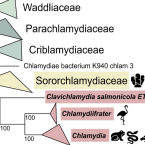
Abstract:
Chlamydiae like Chlamydia trachomatis and Chlamydia psittaci are well-known human and animal pathogens. Yet, the chlamydiae are a much larger group of evolutionary ancient obligate intracellular bacteria that includes predominantly symbionts of protists and diverse animals. This makes them ideal model organisms to study evolutionary transitions from symbionts in microbial eukaryotes to pathogens of humans. To this end, comparative genome analysis has served as an important tool. Genome sequence data for many chlamydial lineages are, however, still lacking, hampering our understanding of their evolutionary history. Here, we determined the first high-quality draft genome sequence of the fish pathogen "Candidatus Clavichlamydia salmonicola", representing a separate genus within the human and animal pathogenic Chlamydiaceae. The "Ca. Clavichlamydia salmonicola" genome harbors genes that so far have been exclusively found in Chlamydia species suggesting that basic mechanisms important for the interaction with chordate hosts have evolved stepwise in the history of chlamydiae. Thus, the genome sequence of "Ca. Clavichlamydia salmonicola" allows to constrain candidate genes to further understand the evolution of chlamydial virulence mechanisms required to infect mammals.
Genome dynamics and temperature adaptation during experimental evolution of obligate intracellular bacteria
2023 - Genome Biol Evol, 8: evad139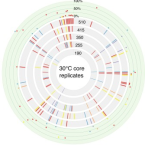
Abstract:
Evolution experiments with free-living microbes have radically improved our understanding of genome evolution and how microorganisms adapt. Yet there is a paucity of such research focusing on strictly host-associated bacteria, even though they are widespread in nature. Here, we used the Acanthamoeba symbiont Protochlamydia amoebophila, a distant relative of the human pathogen Chlamydia trachomatis and representative of a large group of protist-associated environmental chlamydiae, as a model to study how obligate intracellular symbionts evolve and adapt to elevated temperature, a prerequisite for the pivotal evolutionary leap from protist to endothermic animal hosts. We established 12 replicate populations under two temperatures (20 °C, 30 °C) for 510 bacterial generations (38 months). We then used infectivity assays and pooled whole-genome resequencing to identify any evolved phenotypes and the molecular basis of adaptation in these bacteria. We observed an overall reduction in infectivity of the symbionts evolved at 30 °C, and we identified numerous nonsynonymous mutations and small indels in these symbiont populations, with several variants persisting throughout multiple time points and reaching high frequencies. This suggests that many mutations may have been beneficial and played an adaptive role. Mutated genes within the same temperature regime were more similar than those between temperature regimes. Our results provide insights into the molecular evolution of intracellular bacteria under the constraints of strict host dependance and highly structured populations and suggest that for chlamydial symbionts of protists, temperature adaptation was facilitated through attenuation of symbiont infectivity as a tradeoff to reduce host cell burden.
Colocalization and potential interactions of and chlamydiae in microbial aggregates of the coral Pocillopora acuta
2023 - Sci Adv, 20: eadg0773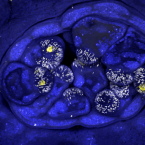
Abstract:
Corals are associated with a variety of bacteria, which occur in the surface mucus layer, gastrovascular cavity, skeleton, and tissues. Some tissue-associated bacteria form clusters, termed cell-associated microbial aggregates (CAMAs), which are poorly studied. Here, we provide a comprehensive characterization of CAMAs in the coral . Combining imaging techniques, laser capture microdissection, and amplicon and metagenome sequencing, we show that (i) CAMAs are located in the tentacle tips and may be intracellular; (ii) CAMAs contain (Gammaproteobacteria) and (Chlamydiota) bacteria; (iii) may provide vitamins to its host and use secretion systems and/or pili for colonization and aggregation; (iv) and occur in distinct, but adjacent, CAMAs; and (v) may receive acetate and heme from neighboring . Our study provides detailed insight into coral endosymbionts, thereby improving our understanding of coral physiology and health and providing important knowledge for coral reef conservation in the climate change era.
One to host them all: genomics of the diverse bacterial endosymbionts of the spider Oedothorax gibbosus
2023 - Microb. Genomics, 9: 10.1099/mgen.0.00094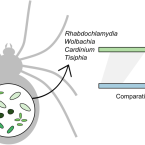
Abstract:
Bacterial endosymbionts of the groups Wolbachia, Cardinium and Rickettsiaceae are well known for their diverse effects on their arthropod hosts, ranging from mutualistic relationships to reproductive phenotypes. Here, we analysed a unique system in which the dwarf spider Oedothorax gibbosus is co-infected with up to five different endosymbionts affiliated with Wolbachia, ‘Candidatus Tisiphia’ (formerly Torix group Rickettsia), Cardinium and Rhabdochlamydia. Using short-read genome sequencing data, we show that the endosymbionts are heterogeneously distributed among O. gibbosus populations and are frequently found co-infecting spider individuals. To study this intricate host–endosymbiont system on a genome-resolved level, we used long-read sequencing to reconstruct closed genomes of the Wolbachia, ‘Ca. Tisiphia’ and Cardinium endosymbionts. We provide insights into the ecology and evolution of the endosymbionts and shed light on the interactions with their spider host. We detected high quantities of transposable elements in all endosymbiont genomes and provide evidence that ancestors of the Cardinium, ‘Ca. Tisiphia’ and Wolbachia endosymbionts have co-infected the same hosts in the past. Our findings contribute to broadening our knowledge about endosymbionts infecting one of the largest animal phyla on Earth and show the usefulness of transposable elements as an evolutionary ‘contact-tracing’ tool.
Gene gain facilitated endosymbiotic evolution of Chlamydiae.
2023 - Nat Microbiol, 1: 40-54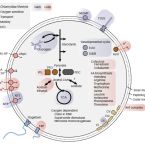
Abstract:
Chlamydiae is a bacterial phylum composed of obligate animal and protist endosymbionts. However, other members of the Planctomycetes-Verrucomicrobia-Chlamydiae superphylum are primarily free living. How Chlamydiae transitioned to an endosymbiotic lifestyle is still largely unresolved. Here we reconstructed Planctomycetes-Verrucomicrobia-Chlamydiae species relationships and modelled superphylum genome evolution. Gene content reconstruction from 11,996 gene families suggests a motile and facultatively anaerobic last common Chlamydiae ancestor that had already gained characteristic endosymbiont genes. Counter to expectations for genome streamlining in strict endosymbionts, we detected substantial gene gain within Chlamydiae. We found that divergence in energy metabolism and aerobiosis observed in extant lineages emerged later during chlamydial evolution. In particular, metabolic and aerobic genes characteristic of the more metabolically versatile protist-infecting chlamydiae were gained, such as respiratory chain complexes. Our results show that metabolic complexity can increase during endosymbiont evolution, adding an additional perspective for understanding symbiont evolutionary trajectories across the tree of life.



